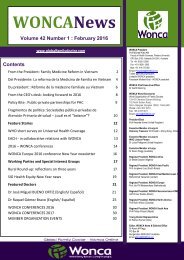Create successful ePaper yourself
Turn your PDF publications into a flip-book with our unique Google optimized e-Paper software.
PROTECT YOURSELF FROM OCCUPATIONAL INFECTIONProtect yourselfAdopt hygienic practices• Wash hands regularly with soap and water. Use alcohol-based hand-cleaner regularly.• Adopt universal precautions in your approach to all patients.• Wear gloves when handling specimens.• Dispose of sharps in the correct manner.Get vaccinated• Get vaccinated against hepatitis B.• All frontline health workers must be vaccinated against influenza.Know your HIV status• If status unknown, test for HIV 60. ART and INH prophylaxis can decrease the risk of TB.• If HIV positive, you are entitled to work in an area of the facility where exposure toTB is limited.Wear a face mask• Wear a N95 respirator when in contact with TB suspects.• Wear a surgical facemask when in contact with influenza suspects.Adopt measures to diminish your risk of occupational infectionProtect your facilityClean the facility• Wash all surfaces (including door handles, telephones, keyboards) dailywith chlorine disinfectant.Ensure adequate ventilation• Regularly clean extractor fans.• Open windows and use fans to increase air exchange.Organise waiting areas• Prevent overcrowding in waiting areas.• Fast track influenza and TB suspects.Manage sharps safely• Ensure sharps containers are easily accessible and regularly replaced.Manage infection control in the facility• Appoint an infection control officer for the facility to coordinate and monitor infectioncontrol policies.Approach to possible occupational exposureTBIdentify TB suspects promptly• The patient with cough ≥ 2 weeks is a TB suspect.• Separate TB suspects from others in the facility.• Educate TB suspect about cough hygiene.• Provide a surgical face mask or tissues to cover mouthand nose to protect others from infection.Diagnose TB rapidly• Aim to complete TB workup within 3 to 4 visits.Protect yourself from TB• Wear an N95 respirator (not a surgical mask) when incontact with an infectious TB patient.HIV• If status unknown, test for HIV 60.• If HIV negative or unknown, start PEP for 1 month assoon as possible (ideally within 1–2 hours):--Give AZT 300mg and 3TC 150mg 12 hourly.Check Hb prior to starting AZT and after 4 weeks.Refer to doctor if Hb < 8.--Add LPV/r 400/100mg 12 hourly if high risk: deepinjury, large bore or biopsy needle, obvious bloodon device, source with AIDS or VL > 100 000.• Repeat HIV test at 6 weeks, 3 and then 6 months.• Advise condom use for 6 months with regular partner.H1N1 influenza• Wash hands with soap and water.• Wearing a surgical face mask over the mouth andnose may be protective when performing procedureson patient suspected of influenza.• Encourage patient who coughs and sneezes to covermouth/nose with a tissue, to ensure used tissues aredisposed of correctly and to wash hands regularlywith soap and water.• Advise patient with symptoms of influenza to stayindoors and avoid close contact with others.100TB HIV CHRONIC RESPIRATORYDISEASECHRONIC DISEASESOF LIFESTYLEMENTAL HEALTH EPILEPSY MUSCULOSKELETALDISORDERS



